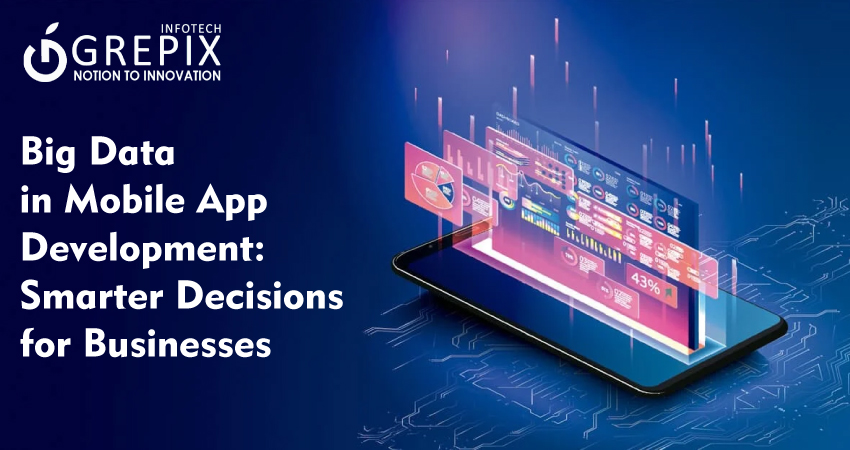Big Data in Mobile App Development: Smarter Decisions for Businesses
The evolution of big data apps, app analytics 2025, and data driven mobile apps is revolutionizing how businesses build, scale, and optimize mobile solutions. These technologies empower organizations to capture actionable insights, deliver personalized user experiences, and boost app performance leading to smarter, data-driven decisions across every stage of app development and deployment.
Big data apps and app analytics 2025 are defining the future of data-driven mobile apps. Businesses now leverage massive datasets and real-time analytics to personalize app journeys, predict user needs, and optimize both marketing and UX in real time. From improved onboarding to predictive maintenance and smarter scaling, big data apps drive engagement, retention, and ROI. This article explores how data-driven mobile apps and smart analytics fuel business growth, presenting real-world examples, case studies, and best practices to help companies lead in today’s competitive app landscape
What Are Big Data Apps and Data-Driven Mobile Apps?
Big data apps are solutions that collect, store, analyze, and apply vast datasets from multiple sources including user activity, device sensors, transactions, and environmental data. Data-driven mobile apps use these insights to guide UX, marketing, personalization, and more, enlisting app analytics 2025 tools to fuel constant improvement.
How Big Data Apps Empower Business-Driven App Development
Data as a Foundation
Incorporating big data apps into the mobile stack allows developers to analyze user interactions, demographic segments, and feature adoption. By leveraging app analytics 2025, teams continuously improve data-driven mobile apps, unlocking benefits such as:
- Personalization by behavior, location, and preferences
- Real-time feature and campaign optimization
- Predictive recommendations and trend analysis
- Rapid detection of bugs and security threats
Core Benefits of Data-Driven Mobile Apps
Personalization with Big Data Apps
Data-driven mobile apps adjust content, notifications, and offers based on user profiles and contextual factors. Netflix, for example, leverages big data apps to tailor movie suggestions and experience flows boosting engagement and reducing churn.
Smarter UX and Retention
App analytics 2025 provides reports on DAU (daily active users), session duration, and journey bottlenecks. Data-driven teams run A/B tests, iterate UI/UX, and optimize onboarding, leading to higher engagement and reduced dropoffs.
Predictive Features and Adaptive Experiences
Big data apps empower predictive analytics anticipating upcoming user needs, forecasted spikes in usage, and personalizing app pathways. Walmart’s integration of predictive analytics improved inventory control and boosted revenue by minimizing stockouts.
App Performance and Security Monitoring
Continuous, real-time data from app analytics 2025 supports bug tracking, crash resolution, and security threat detection proactively safeguarding the user experience.
How Big Data Helps Scale Mobile Apps
- Forecasting Growth: Predictive analytics in data-driven mobile apps assesses future usage, server loads, and resource needs helping businesses prepare scalable infrastructures.
- Dynamic Resource Allocation: App analytics 2025 helps apps scale server resources just-in-time, preventing outages during peak periods.
- Market and Feature Fit: Analysis of user feedback and usage patterns informs which features to prioritize, expand, or sunset for maximum ROI.
Case Studies: Big Data Apps Transforming Businesses
Walmart: Inventory Optimization
Walmart’s data-driven mobile apps combine sales, weather, and location data for real-time demand forecasting. They report reduced inventory surplus, improved customer satisfaction, and millions in annual savings.
Netflix: User Personalization
Netflix utilizes big data apps to analyze viewing history, search trends, and user ratings—delivering highly accurate personalized recommendations. This approach has driven a significant rise in daily active users and session durations.
Uber: Dynamic Pricing and Operations
Uber’s data-driven mobile apps process weather, event, and traffic data to optimize fare multipliers and driver allocation across cities, resulting in increased reliability and efficiency for users.
Johns Hopkins Hospital: Healthcare Predictions
By implementing app analytics 2025 and predictive modeling within patient mobile platforms, Johns Hopkins reduced patient readmission rates by 10%, improving personalized care and lowering costs.
Must-Have Features in Data-Driven Mobile Apps (2025)
- Advanced Analytics Dashboards: Access to detailed, live user and session reporting.
- Automated Personalization Engines: Machine learning modules that adapt content in real time.
- Behavioral Segmentation: Target users with tailored marketing and messaging.
- A/B Testing and Experimentation Tools: Iterate on features using real user responses.
- Real-Time Security & Fraud Monitoring: Identify suspicious activity instantly, protecting user data.
- In-App Feedback Loops: Collect user sentiment and prioritize fast improvements.
- Efficient Data Pipelines: Scalable cloud data storage and processing, compliant with privacy laws.
Key Statistics: App Analytics 2025 & Big Data Apps
- 87% of enterprise apps will be data-driven mobile apps by the end of 2025.
- Businesses using app analytics 2025 for feature prioritization see a 25–50% increase in user engagement within a year.
- Predictive analytics in big data apps is saving businesses $10B annually in failed development costs by optimizing features and experiences early.
- Personalized recommendations based on big data increase average app revenue per user (ARPU) by up to 30%.
The Future of App Analytics 2025 and Data-Driven Mobile Apps
- AI & Machine Learning: Automated insight generation and anomaly detection will fuel the next wave of big data apps.
- Real-Time Personalization: Data-driven mobile apps will tailor content, offers, and even UX based on second-by-second analysis.
- Privacy by Design: Smarter data collection focusing on user consent and anonymization will be essential in app analytics 2025.
- Seamless IoT & Wearables Integration: Big data apps will unify phone, wearable, and smart device data for holistic user insights and smarter business decisions.
Conclusion
Big data apps, app analytics 2025, and data-driven mobile apps are changing how businesses operate and scale. By tapping into vast and actionable data, enterprises create smarter, more personalized mobile experiences that drive key metrics engagement, retention, and ARPU while minimizing risk and development costs. As competition intensifies in 2025, businesses adopting app analytics 2025 and data-driven mobile apps will command a decisive edge in user satisfaction and ROI. Ready to elevate your app strategy? Start building data-driven mobile apps share this guide and take the next step toward smarter digital business.
FAQs
1. What are big data apps in mobile development?
Big data apps collect, store, and analyze large-scale user, device, and contextual data transforming these insights into smarter, more effective mobile app experiences and business decisions.
2. How do app analytics 2025 benefit app businesses?
App analytics 2025 empower data-driven mobile apps with real-time tracking of engagement, churn, DAU, and in-app behavior guiding agile feature releases and marketing strategies.
3. What real-life companies use data-driven mobile apps?
Walmart (inventory optimization), Netflix (recommendations), and Uber (dynamic pricing) all rely on big data apps for core user experience and competitive advantage.
4. What features define leading app analytics 2025 solutions?
Advanced dashboards, segmentation, live feedback collection, A/B testing, and privacy-focused data infrastructure are critical to leading data-driven mobile apps.
5. How does big data support mobile app scaling?
Data-driven mobile apps with predictive analytics help businesses forecast traffic, prevent outages, and dynamically expand server and marketing resources during peak growth.







